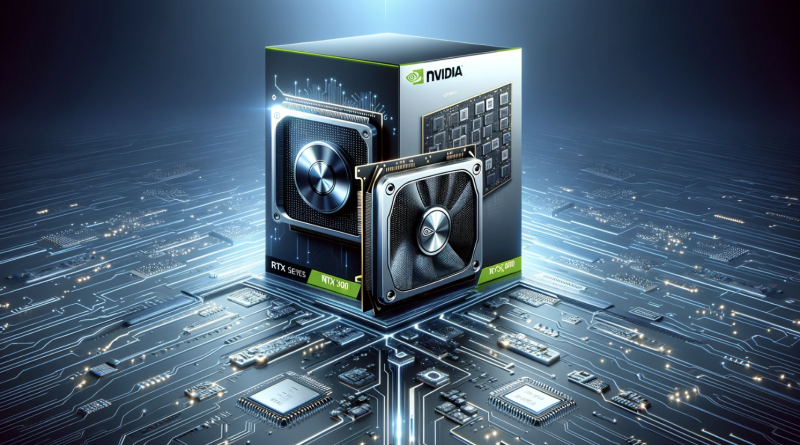Nvidia Unveils RTX 500 and 1000 Series Ada Generation GPUs for Mobile AI Applications
In a groundbreaking development, Nvidia has officially announced the launch of its RTX 500 and 1000 Ada Generation laptop graphics processing units (GPUs), setting a new standard for on-the-go artificial intelligence (AI) processing and graphics performance. These cutting-edge GPUs, built on the sophisticated Ada Lovelace architecture, are engineered to meet the growing demands of content creators, researchers, and engineers, providing unparalleled AI acceleration and graphics capabilities directly from portable devices.
Transforming Mobile Work with AI Acceleration
As the world leans more towards generative AI and hybrid work models, the need for powerful mobile computing solutions has never been more critical. Nvidia’s RTX 500 and 1000 GPUs emerge as the answer to this call, offering a perfect blend of generative AI capabilities and superior graphics performance tailored for professionals facing a variety of challenges in their daily tasks.
The announcement, made in anticipation of the Mobile World Congress event in Barcelona, marks a significant milestone in Nvidia’s commitment to advancing mobile computing technology. The introduction of these GPUs is expected to revolutionize the way professionals work, enabling creativity and efficiency to flourish without the constraints of traditional workstations.
Features and Performance: A Closer Look
The Ada Generation GPUs redefine the capabilities of mobile workstations with their advanced features and performance metrics. Here’s a detailed overview of what these GPUs bring to the table:
- Architecture: Built on the Ada Lovelace architecture, these GPUs promise a quantum leap in AI processing and graphics rendering capabilities.
- AI Acceleration: With the inclusion of a neural processing unit (NPU) alongside Nvidia’s RTX GPU equipped with Tensor Cores, the GPUs are designed to handle both lightweight and intensive AI tasks, boasting up to 682 TOPS of AI performance.
- Enhanced Productivity: The GPUs are optimized for a range of professional workflows, including video editing, graphic design, and high-quality video conferencing, thanks to advanced AI acceleration.
Revolutionary Features at a Glance:
- Third-Generation RT Cores: For real-time ray tracing.
- Fourth-Generation Tensor Cores: Enhancing AI-driven applications.
- Ada Generation CUDA Cores: For superior compute performance.
- Dedicated GPU Memory: Ensuring smooth multitasking and heavy workloads.
- DLSS 3 Technology: For groundbreaking graphics performance.
- AV1 Encoder: Facilitating efficient video streaming and encoding.
Unprecedented Performance Metrics
The performance enhancements introduced by the RTX 500 and 1000 GPUs are nothing short of spectacular. These GPUs are designed to significantly improve various aspects of professional workflows:
- Generative AI Performance: The RTX 500 GPU delivers up to 14 times the generative AI performance for applications like Stable Diffusion.
- AI-Assisted Photo Editing: Experience up to 3 times faster photo editing capabilities.
- 3D Rendering: Achieve up to 10 times the graphics performance for 3D rendering tasks compared to CPU-only configurations.
Expanding the Ada Lovelace Architecture Lineup
These new GPUs join Nvidia’s impressive lineup of Ada Lovelace architecture-based laptop GPUs, which includes the RTX 2000, 3000, 3500, 4000, and 5000 series. This comprehensive range caters to a wide array of needs, from advanced rendering and data science to deep learning workflows, meeting the demands of 3D creators, businesses, and researchers alike.
Availability and Global Partnerships
Nvidia’s RTX 500 and 1000 Ada Generation Laptop GPUs are set to be available this spring, featured in mobile workstations from leading global manufacturers such as Dell Technologies, HP, Lenovo, and MSI. This collaboration ensures that professionals across various industries can access the latest in AI and graphics technology, facilitating a new era of productivity and creativity.
Conclusion
Nvidia’s launch of the RTX 500 and 1000 Ada Generation laptop GPUs marks a significant advancement in mobile computing technology. By offering unmatched AI acceleration and graphics performance in a portable form factor, Nvidia empowers content creators, researchers, and engineers to achieve more, regardless of their location. As these GPUs become available in the coming months, the potential for innovation and efficiency in professional workflows is bound to reach new heights, reshaping the landscape of mobile computing for years to come.
Table: Nvidia RTX Ada Generation Laptop GPUs Comparison
| Model | AI Performance | Generative AI Capabilities | Graphics Performance | Use Cases |
|---|---|---|---|---|
| RTX 500 | Up to 682 TOPS | Up to 14x | Up to 10x | Video editing, AI photo editing |
| RTX 1000 | Up to 682 TOPS | Advanced | Superior | High-end content creation, 3D rendering |
| RTX 2000 Series | High | High | High | Professional content creation |
| RTX 3000 Series | High | High | High | Advanced rendering, simulations |
| RTX 4000 Series | High | High | High | Data science, AI model training |
| RTX 5000 Series | High | High | High | Deep learning, complex workflows |
Key Takeaways:
- Unparalleled AI and Graphics Performance: The RTX 500 and 1000 GPUs bring desktop-class performance to mobile workstations.
- Innovative Architecture: Leveraging the Ada Lovelace architecture, these GPUs provide the foundation for the next generation of AI and graphics computing.
- Versatile Applications: From AI-enhanced video conferencing to advanced 3D rendering, these GPUs are equipped to handle a wide range of professional tasks.
- Global Availability: Set to be featured in mobile workstations from leading manufacturers, ensuring wide accessibility for professionals worldwide.
Nvidia’s introduction of the RTX 500 and 1000 Ada Generation laptop GPUs not only showcases the company’s leadership in AI and graphics technology but also highlights its commitment to driving innovation in mobile computing. As these GPUs become integral to the workflows of professionals across industries, the future of on-the-go productivity and creativity looks brighter than ever.

